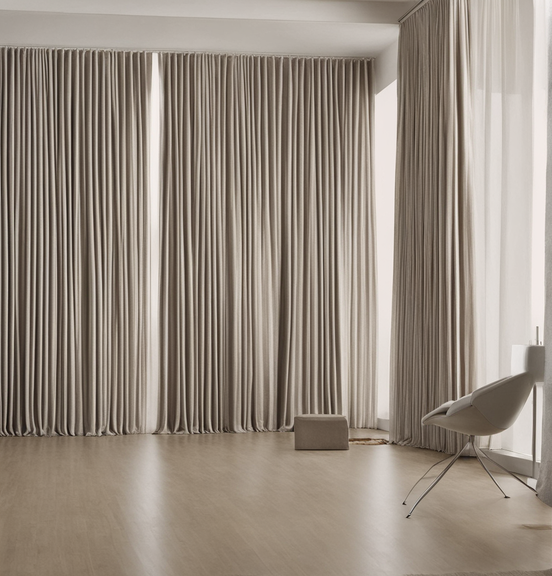Introduction
Curtains are a key component of interior design because they provide both practicality and aesthetic appeal. The length of the curtains in relation to the floor is an important design consideration.
The essential question in the context of curtain length is whether or not should curtains touch the floor? This question prompts conversations and thoughts regarding a variety of variables, including beauty, practicality, and personal preferences. Choosing the right curtain length can be a difficult decision for homeowners.

The length of the curtains you choose can have a big impact on the way a room looks and feels in general. For instance, floor-length curtains give off an air of grandeur and elegance. They increase the apparent height of a room, giving it a grand and luxurious feel. Drapes that fall short of the floor, on the other hand, might give off a more relaxed and modern vibe.
And in this post, we will go over this topic of Should curtains touch the floor?, in depth, and you will find the solution to your difficulty.
Table of Contents
Different Lengths Of Curtains
Curtains are available in a variety of lengths, each with its own set of qualities that can affect the aesthetics and functioning of a place. Floor-length curtains, below-window sill curtains, and café curtains are the three most typical curtain lengths. By getting the information about lengths you can easily determine that should curtains touch the floor? .
- Floor-Length Curtains:
As the name implies, floor-length curtains cover the entire window. They are renowned for their beauty and class throughout time. These drapes give a room a sense of grandeur and elegance, giving the impression that it is taller and larger. For formal living rooms curtains and curtains behind beds where a touch of refinement is sought, floor-length drapes are frequently selected. They provide superior insulation, privacy, and light control.
- Curtains for below-window sills:
Usually suspended just below the windowsill, below-window-sill curtains cover the window frame and a portion of the wall. They are a flexible option that works with many interior design aesthetics. When compared to floor-length choices, these curtains offer a more relaxed and contemporary appearance. They maintain some measure of privacy while allowing plenty of natural light in. In kitchens, below-window sill drapes are frequently employed.
- Café curtains:
Café curtains are often shorter and only cover the bottom third or half of a window. They are frequently picked because of their endearing and quaint appearance. With café curtains, you can keep your privacy while yet letting a lot of light enter through the top of the window. They are a common option for breakfast nooks, dining rooms, and kitchens.

Are My Curtains Supposed To Touch The Floor?
Several criteria, such as your personal preferences, the style you want to achieve, and the practicality of the curtains in your particular area, will determine whether or not should curtains touch the floor? To assist you in making a wise choice in should curtains touch the floor or window sill? ,take into account the following:
- Aesthetic Preference:
Floor-length curtains may give a room a feeling of elegance and grandeur, making it seem taller and more upscale. They frequently function well in formal settings where a more opulent atmosphere is desired, like living rooms and dining rooms. Floor-length curtains might be the best option if you prefer a conventional or classic style even if you have arched windows.
- Room Functionality:
Take into account the use of the space. For improved privacy and light control in bedrooms, for instance, floor-length drapes are a need for getting a good night’s sleep. In contrast, shorter curtains that don’t reach the floor may be more useful and help to maintain cleanliness in a kitchen or bathroom.
- Interior Design Style:
The type of curtains you choose can be influenced by your interior design style choice. Shorter curtains, which present a cleaner, sleeker appearance, are frequently preferred in modern and minimalist designs. On the other side, longer, flowing curtains may be incorporated for a relaxed and layered aesthetic in more eclectic or bohemian settings.
- Room Dimensions:
The size of the room may influence your choice for should curtains touch the floor? Floor-length curtains may be too much for smaller rooms, giving the impression that it is confined. They can increase the feeling of grandeur and space in spaces with high ceilings that are bigger.

How Much The Curtains Should Touch The Floor?
The following general rules will assist you in choosing the right curtain length:
Slight Floor Touch:
Many interior designers favor drapes that only skim or barely touch the floor. The sleek, fitted design of this style keeps extra fabric from piling up on the floor. To do this, take a measurement from the curtain rod or track to the floor and, for a slight touch, deduct around 1/2 to 1 inch (1.27 to 2.54 cm).
Floor-Length Curtains:
Because they exude an air of richness and elegance, floor-length curtains are a popular option. These drapes should have a very little break or should barely touch the floor. Measure from the curtain rod to the floor without deducting any extra length to get this effect.
Puddling curtains:
For a more dramatic and luxurious effect, puddling curtains are made to fall or gather on the floor. For formal areas like dining rooms and lavish living rooms, this design is frequently used. Add additional fabric length to your measures, often 6 to 12 inches (15.24 to 30.48 cm) or more, depending on your liking, to create a puddling look.

Conclusion: “Should the curtains touch the floor?”
In conclusion, the topic should curtains touch the floor? has been covered in this debate. We have looked at the aesthetic value and practicality of a range of curtain lengths, including café, floor, and below-window sill curtains. We’ve also emphasized the value of style and individuality in curtain selection, as well as how interior design trends can affect these decisions.
And now the answer to the question “Should the curtains touch the floor?” is obvious that there is no single, appropriate response. Numerous elements, such as individual preferences, room functioning, interior design style, and pragmatic concerns, all play a role in the choice.
